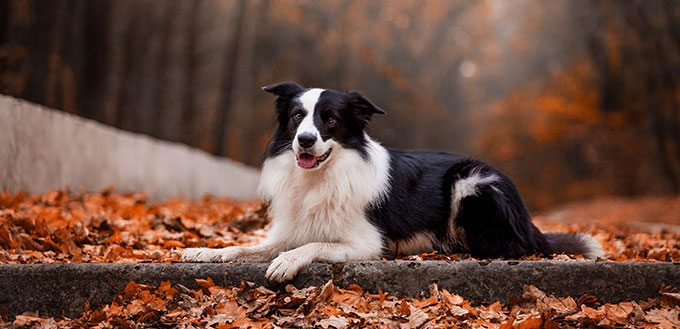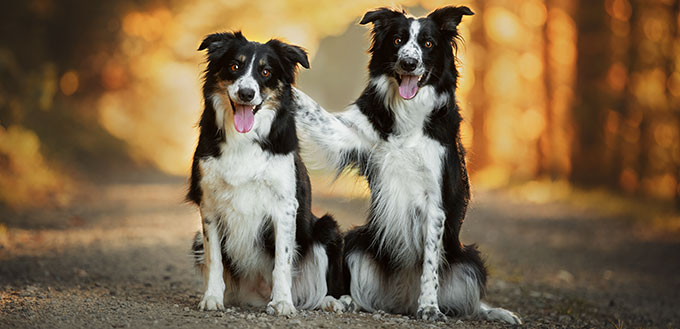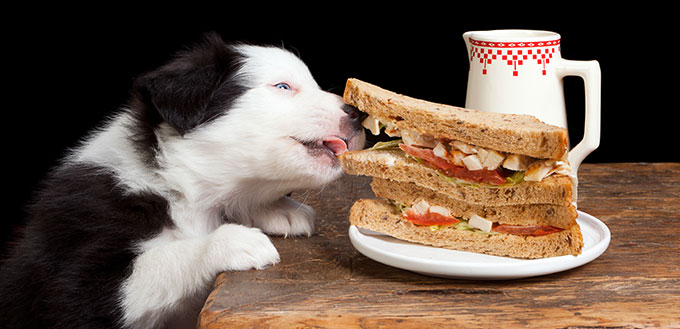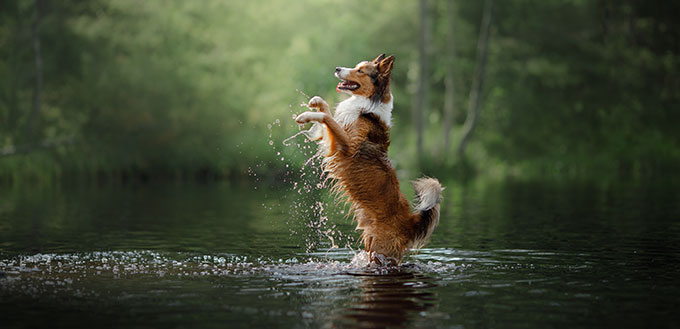Intelligent, energetic and loyal, the beautiful Border Collie is a dog that loves a job to do – whether that’s herding sheep, mastering agility or playing with his favorite humans. And all that canine get-up-and-go means that he needs a family that has the time and energy to keep their collie happy and occupied.
We take an in-depth look into what makes this hardworking breed tick and how, with the right home and handling, they can make an awesome pet.

Breed Overview
Dog Breed Group: Herding group
Height: Males: 19-22 inches; Females: 18-21 inches
Weight: 30-50 pounds
Life Expectancy: 12 to 15 years life span
History of the Border Collie
The history of today’s Border Collie dog breed goes back to ancient Britain and its invasion of Scotland and England by both the Romans and the Vikings. It all started with the Romans who brought their own herding dogs to work the livestock. These large animals remained in Britain for three centuries until the Vikings arrived, with their own, smaller Spitz-type herders, resulting in a crossbreed between the two. Compact, agile and fast, so perfectly suited to herding and guarding sheep in the rocky and hilly terrain, this was the start of the Border Collie breed we know today.
Long considered one of the world’s greatest herders, the breed developed its distinct herding style – with explosive running and its stealth in crouching and creeping around its flock still seen in the modern-day breed.
The Border Collies we know today are thought to date back to the 1700s. As an exceptional herding dog breed, the Border Collie soon became invaluable to hill shepherds and the best stock were bred together to fine-tune the breed. The word Collie is derived from the Scottish dialect in its translation of ‘sheepdog’ and indicates its Highland heritage. The Collie also evolved to be associated with its particular environment, with the dog breed also becoming known by its region, such as the Welsh Sheepdog, Northern Sheepdog and the Highland Collie.
By the 19th century, the Border Collie had become a favorite amongst the English upper class and was used to work livestock on their estates as well as for breeding and dog sports. The popularity of the Collie grew, with Queen Victoria known to be an enthusiast of the breed and by the late 19th century, the competitive field sport of sheepdog trials was established. Known for their intelligence and high trainability, the versatility of the Border Collie was also starting to be recognized, which is still seen today, in their agility work and dog sports as well as working as service dogs, in particular, search and rescue.
The first Border Collies arrived on US soil towards the end of the 1800s, and as superior herding animals, played a key role in the expansion of farming in the West, as more sheep were being imported. But one dog – known as Spot 308, who was Supreme Champion in 1923 – is considered the first of today’s American Border Collie breed.
The popularity of Border Collies slowly grew – breeders focused on breeding for either working dogs or for the show ring – and by 1995, the Border Collie dog breed was formally recognized by the American Kennel Club.
Breed Information
Fizzing with energy and intelligence, the Border Collie was bred to work and is considered one of the world’s best herding breeds. The breed’s distinct herding style – crouching low and with stealth moves, coupled with bursts of fast-paced running and agility – means that Border Collies are still coveted as sheep herding dogs today. But their good looks, size and trainability, as well as loyalty, means that Border Collies can also make good family pets.
But with that high energy drive, stamina and intelligence, this is a dog that needs stimulation, both physical and mental, to keep them occupied and happy. And that means Border Collies need a confident, active owner and a home life suited to an outdoor lifestyle.
As a medium sized dog, Border Collies are a hardy breed designed to be on the go all day, so will need plenty of exercise; they are also well-suited to agility sports thanks to their smart brain. And their work ethic means they are loyal and with the correct training, obedient, and will love to spend time with their family. However, they can be wary of strangers, so will need socialization from an early age.
Border Collies are in the main good with children and they certainly love to play. However, their instinct to herd is always bubbling under the surface and they can have a tendency to bring their herding into the home. This means that other pets and children could get the Collie herding treatment, and with their instinct to nudge, nip and bark, they are best in a family with older children.
With the right training and consistent handling, the Border Collie is a canine best friend for life. And for a medium-sized dog, they certainly have a good life span and can live for around 15 years.
If you are still considering whether a Border Collie is the right pet for you, here’s the lowdown on the essentials you need to know about this smart, energetic breed.
Breed Appearance
With their ‘as nature intended’ looks, the Border Collie is not a preened and neat dog but is still ruggedly handsome and sleek in appearance. As well as working animals, they also make excellent show dogs.
Dog Size
The Border Collie size is classed as a medium-sized, and he is built to be agile and stealth-like, with a lean, muscular body to support all that herding athleticism. Male Border Collies can stand up to 22 inches, while females are a just and inch or so shorter; the collie’s body shape means they are slightly longer than they are tall. The Border Collie’s body length is extended by their brush-like tail, which boasts plenty of feathered fur. Their head is also slim, with a long muzzle and intelligent, alert eyes, top set with ears that can be fully erect, dropped or one of each! The most common eye color for the Border Collie is shades of brown, including gold and amber, while blue eyes are more common in blue merle coated collies.
Coat
Perfect for the outdoor life, the Border Collie is shrouded in a feathered, double layer coat that can be either rough or smooth. The rough type is typically of medium length, with a mane-like ruff and extending to feathering on their belly, chest and legs and can be either straight or slightly curly. The smoother coat is shorter and tends to be coarser with much less feathering throughout the legs and body.
As a double coat – with a coarse outer and a soft undercoat – the Border Collie’s fur is weather-resistant and helps to keep them both warm and dry.
When it comes to Border Collie coat color, the most common is a black and white combination, typically with a predominately black body and a white blaze on the face, neck, legs and tail tip. The Border Collie can also be seen in other colors, including red and grey, either as solid, tri or bicolor. Blue merle and speckled coats are also often seen.

Fun Facts
Before we explore the Border Collie in more depth, here are a few facts about this smart, fizzy and fun breed:
- One of the most famous Border Collies on the silver screen is the character of Fly, who featured alongside her mate Rex and Babe the pig in the 1995 animation film, Babe.
- Given the chance, a Border Collie will try to herd anything nearby, including acts, children, cyclists and even cars.
- Border Collies can be shy and reserved when it comes to strangers, making them a good choice for a home guard dog.
- The word ‘Collie’ originates from the Scottish dialect and means sheepdog.
- On a trip to her Scottish home of Balmoral in the 1860s, Queen Victoria first met a Border Collie and became a life-long enthusiast of the breed.
- Widely considered the most intelligent dog breed, a Border Collie can learn a new command within five seconds.
- Robert Burns, the famous Scottish Poet, featured his own Border Collie, named Luath, in one of his most popular poems, ‘The Twa Dogs’.
- Border Collies are record breakers, including a collie called Chaser who knows the names of over 1,000 objects and Sweet Pea, a Border Collie Mix, who in 2008 set a record for dog balancing, walking 100 meters in 2 minutes 55 seconds with a can balanced on her head.
Personality
First and foremost, when it comes to the Border Collie temperament, he is a working dog at heart, and this will show in their energetic personality that craves a job to do. If this energy is channeled correctly, then the collie will make a fun, active and engaging pet, that loves to play as much as they love you. And while he is loyal and enjoys your company, don’t expect him to be cuddle monster – he enjoys affection, but it is fair to say he’d prefer you show your love through attention of the more active kind!
This breed is renowned for its intelligence and has energy to spare so be prepared to keep up with your collie and make sure you have the time to get out and about with him as he loves to run, which means he is a great candidate for obedience training, agility and other canine sports. He also loves water, although he is not the most natural of swimmers. And he will also need plenty of exercise and mental stimulation to stop that sharp collie mind from getting bored. Games, challenges, puzzle toys, ball and fetch in the garden, you need to get physical with the collie to keep him happy. Luckily with that sharp brain, he loves to learn so neither of you will get bored!
With early training and socialization, the Border Collie fits in well with the family unit and will become a much-loved playmate for the kids. They respond best to positive praise and reward, but you need to be consistent with their training and handling as they can have over-protective traits as well as be a little too ‘herdy’ with other family pets. Border Collies can also be on the sensitive side and shy of strangers.
Care
With the personality traits of the energetic Border Collie, knowing how to take care of your new pet is essential for any dog owner. We look at the care essentials you need to know when it comes to making this awesome breed your latest family member.
Training
With his razor-sharp intelligence and strong work ethic, the Border Collie is a natural for training, but they also need firm and positive leadership to get the very best out of this super-smart dog. Starting early with a Border Collie puppy is essential, for both obedience training and socialization so you can keep some of his less than desirable traits, such as the drive to herd, in check. Collies also respond best to positive reinforcement and, as they require mental stimulation to keep focused, needs plenty of variety in both his training and play sessions. Enrolling them on agility training or getting involved in other dog sports is a good way to go.
Exposing your young Border Collie puppy to new people and situations from an early age will also help to reduce their tendency to be reserved and get them comfortable in the company of people and other animals outside of their family unit. And as a final word on training the Border Collie, discipline, consistency, variety and routine will bring you the very best results.
Feeding

While it may be tempting to feed for their energy level, it’s important that you manage the daily portions of food you give to your Border Collie to prevent them from getting overweight or obese. A high-quality dry dog food, with premium protein is the best way to feed your collie, ideally, 1.5 to 2 cups a day, split over two meals, and accompanied by plenty of fresh water. However, the quantity of food needs to be adjusted to take into account your dog’s activity levels, especially if they are a working dog. The type of dog food you give your Border Collie also needs to be appropriate to their life stage too (whether that’s puppy, adult or senior) as well any health issues they may have.
Check out Best Dog Food for Border Collies.
Grooming
Whether you have the longer coated variety or the smooth, Border Collies are generally considered average shedders so won’t need a complicated grooming routine. But you do need to keep it consistent to ensure that hardworking, weatherproof coat is up to the outdoor job.
Brushing your Border Collie once or twice a week with a pin brush will not only help to keep any shedding under control but keep their coat healthy and mat and tangle free. But if you and your dog lead a particularly active outdoor lifestyle, quickly brushing through their coat at the end of their walk to remove any debris is a good habit to have.
Your Border Collie will also go through the twice-yearly shedding seasons – Spring and Fall – when they ‘blow’ their undercoat so upping your grooming to daily during this time will help to keep everything neat. And other than if they get particularly dirty, you won’t need to excessively bathe your collie, around four times a year should be enough.
A Border Collie grooming routine should also include trimming their nails around once a month, if needed, and weekly checks of their ears and eyes, gently cleaning as necessary. And don’t forget their dental health either, as brushing two to three times a week will help to keep their canines healthy and tartar free.
Check out our articles on the best dog nail clippers, best dog shedding brush, best shampoo for puppies, best dry shampoo for dogs, and best dog dental spray.
Health
As a herding dog bred to work outdoors, the Border Collie is known to be a hardy and generally healthy animal which has a decent life span. Saying that, they can still be prone to some health issues as well as some genetic conditions.
While reputable breeders should test a litter and the parents for the main conditions, you should be aware of the main health issues which could affect your new Border Collie:
Trapped neutrophil syndrome (TNS)
This is a hereditary and fatal condition that has only been found in Border Collies. With trapped neutrophil syndrome, the bone marrow doesn’t transfer neutrophils (which trap and kill pathogens) to the blood, reducing the effectiveness of the immune system. Sometimes evident at birth, the condition can also have mild symptoms, meaning it is often not seen until several months later when the puppy’s immune system is depleted.
Hip dysplasia
Border Collies can also be affected by hip dysplasia, where the thighbone doesn’t fit correctly into the hip joint, causing pain, lameness and arthritis as the dog ages.
Progressive Retinal Atrophy (PRA)
Affecting the eye’s retina, PRA gradually reduces the Border Collie’s eyesight, leading to eventual blindness.
Collie Eye Anomaly
Another inherited condition, Collie eye anomaly causes changes in the eye, including defects in the optic disc and retinal detachment and normally occurs by the time the puppy is two years old.
Epilepsy
This neurological condition can also be inherited, and ranges from mild to severe seizures. In many cases of idiopathic epilepsy, it can be treated and managed if prompt veterinary treatment is obtained.
Deafness
Border Collies also have a higher incidence of deafness, with 3.6% of collies presenting with hearing loss in one or both ears, compared to the 0.025% of the overall domestic canine population. The condition can be age-related as well as linked to the merle gene, with merle-colored collies, who have blue eyes experiencing higher rates of deafness.
Osteochondrosis Dissecans (OCD)
Caused by inadequate growth of cartilage in their joints, typically the elbow. OCD causes stiffening of the joint, leading to pain and mobility difficulties as the dog eventually loses its ability to bend its elbow.
Exercising
The Border Collie is not described as a dynamo by accident, as many owners will attest. The energy level of this dog breed is something else and will need managing to keep everyone happy. Border Collies need plenty of exercise on a daily basis, at least two hours, which can be a bit of a shock to the new collie parent, but it can be made easier by splitting it into two walks a day, with plenty of playtime in-between for more physical and mental stimulation. The ideal pet parent for a Border Collie is someone who is naturally active and loves the outdoor life, as this breed is also wonderful to take on long hikes. But if you are not a particularly active family or your work life doesn’t allow for such long exercise sessions with your pet, then a Border Collie may not be the right dog breed for you.
Adopt Don’t Shop (Rescue Groups)
With the energy level and exercise requirements that come as part of the Border Collie package, sadly this breed can find itself in the local shelter network as some pet owners realize that they are unable to meet the breed’s needs. Which means that, if you are looking to make a Border Collie a new family member, there may be the opportunity to rehome a surrendered pet.
If you are looking to adopt rather than shop a Border Collie and you don’t mind re-homing an older dog, then checking out your local rescue groups or dog shelters is a good first step. Or contact the Border Collie Society of America which runs its own rescue program for more information. The BCSA also lists the contact details of some of the country’s leading Border Collie Rescue charities and organizations.
Price
A fully trained Border Collie can fetch a tidy sum as a working dog. In fact, the most expensive Collie – a female called Kim – made a Guinness World Record early in 2021 when she sold for an eye-watering $38,893!
Border Collies sold as pets can also command a premium, so you can expect to pay from between $600-$1,200 to as high as $4,000, depending on its breeding. And that doesn’t take into account the expense of feeding, training and caring for your new pup throughout its life.
If you do have your heart set on a Border Collie pup, always do your research and go to a reputable breeder – the American Kennel Club lists Border Collie Breeders around the country.
When buying from a breeder, always do your research first and ask questions about the litter, their parents and health; ask to see the parents too, as well as information on their grandparents. The breeder should also be committed to finding the very best home for their Border Collie puppies, and should ask you questions too, so they can assess your suitability to take one of their pups.

FAQs:
Q: Are Border Collies a good family dog?
A: As long as he is trained and socialized from an early age, Border Collies make fantastic pets, especially for active families who like to get out and about with their pet. Border Collies are best suited to families that have the time to exercise and play with them and build up a relationship, and they also need a strong human ‘pack’ leader to keep their energy and smart brain positively focused and engaged.
However, Border Collies have in-built herding instincts, so if not managed and trained, he can ‘herd’ his family, especially children and other pets. For this reason, Border Collies should always be supervised when around younger children, and older children taught how to behave with their dog. But the loyalty and love of companionship and play means a Border Collie can happily become your youngster’s best friend and share lots of adventures together!
Q: Do Border Collies bark a lot?
A: Border Collies certainly have a lot to say, and they can get very vocal about it! Known as a barking breed, the Border Collie uses their bark to communicate as well as raise the alarm and you could find they bark at everything, especially anything moving quickly, such as bikes and passing cars. And, with their natural reserve towards strangers, their guarding instinct will trigger their barking alarm. Keeping your Border Collie focused can help with their barking, as can causing a distraction, while obedience training can help. But barking is part of this breed, which means you may need understanding neighbors.
Q: Do Border Collies like to cuddle?
A: Like with most breeds, it does depend on the dog, but the Border Collie loves attention and affection, and so should enjoy a cuddle. But don’t be offended if the reason for that puppo snuggle from your Border Collie isn’t all hearts, as this is also an outdoor working dog, that recognizes the warmth and comfort that a cuddle can also offer!
Just don’t expect your Border Collie to be a couch potato, cuddling for hours, as this is a breed that likes to be active and have something to do. And he has plenty of other ways to show his affection and loyalty.







